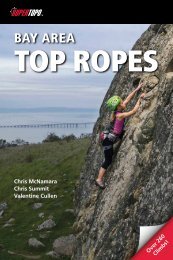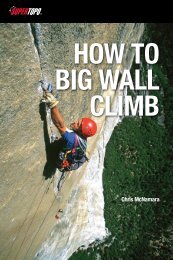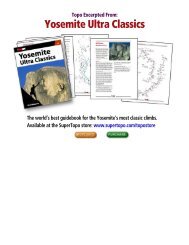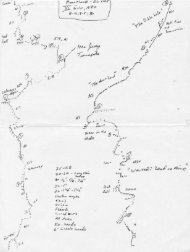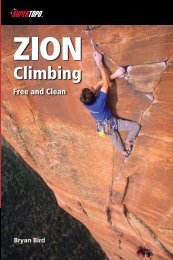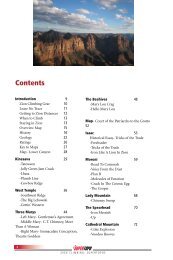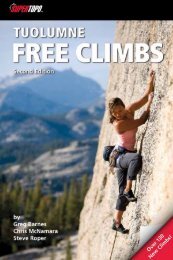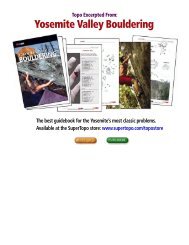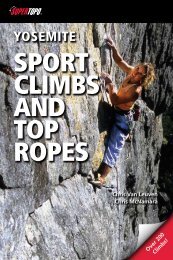The Definitive Guide To Yosemite Big Wall Climbing - SuperTopo
The Definitive Guide To Yosemite Big Wall Climbing - SuperTopo
The Definitive Guide To Yosemite Big Wall Climbing - SuperTopo
You also want an ePaper? Increase the reach of your titles
YUMPU automatically turns print PDFs into web optimized ePapers that Google loves.
Abandoned/Unattended Property<br />
Property left unattended for longer than 24<br />
hours can be impounded. If it is impractical<br />
to return within 24 hours, leave ropes and<br />
equipment in place only as long as you are<br />
actively using them. Leaving your stash of gear,<br />
ropes, and supplies on top of El Cap for your<br />
personal convenience and storage year after<br />
year is selfish and not acceptable. Imagine what<br />
it would look like if every climber did the same,<br />
or if hikers were allowed to cache gear all over<br />
the park! Label and date equipment, ropes, and<br />
water bottles with your contact information<br />
if you have a reasonable plan to return to<br />
unattended equipment to avoid removal.<br />
Fixed Ropes<br />
Ropes fixed on walls are treated the same<br />
way as other unattended property. If you fix<br />
ropes, only do so immediately before beginning<br />
your ascent, and remove them once committed<br />
to the route. If you plan to return to a project<br />
regularly, leave your ropes in place only when<br />
you are actively working the route. Do not leave<br />
ropes or gear on popular routes–this takes away<br />
from the experience of other climbers, and<br />
can potentially create unsafe conditions. Once<br />
again, the “alpine” style was initiated by Valley<br />
climbers–check out the history of the Muir<br />
<strong>Wall</strong> or the South Face of Mt. Watkins later in<br />
this book.<br />
<strong>The</strong> “established” fixed ropes below Heart<br />
Ledges, East Ledges, and on the Slabs approach<br />
to Half Dome are not maintained or condoned<br />
by the NPS. Do not expect these ropes to be<br />
in place, and be prepared to climb or descend<br />
without them.<br />
<strong>The</strong> recent popularity of big wall free-climbing<br />
has added thousands of feet of fixed rope to<br />
long routes. Free climbers often rappel in to<br />
work their routes, leaving the ropes in place<br />
for easy access. By the fall of 2010, after a busy<br />
climbing season, all but a few pitches of Salathé<br />
<strong>Wall</strong>/Freerider had been fixed by free climbers<br />
and most of the lines were still abandoned<br />
in place as winter approached. This behavior<br />
could ultimately lead to more restrictions. It’s<br />
amazing that there are now so many climbers<br />
able to free the Grade VIs, but consider waiting<br />
until you’re strong enough to attempt them<br />
20<br />
YOSEMITE BIG WALLS SUPERTOPOS<br />
ground up or at least remove the lines when<br />
you are not using them.<br />
Clean <strong>Climbing</strong><br />
Please respect “clean climbing” ethics<br />
on all routes, long and short. Avoid nailing<br />
whenever possible and don’t drill new holes for<br />
hook placements or chisel head placements.<br />
Never fabricate holds or change the nature of<br />
established climbs.<br />
Bolting and New Routes<br />
CLIMBER IMPACTS<br />
Hand drilling protection or anchor bolts is<br />
OK but motorized power drills are prohibited.<br />
When you place a new bolt, keep in mind<br />
that you are permanently altering the rock.<br />
If planning a new wall route, take the time to<br />
talk to the local <strong>Yosemite</strong> climbing community<br />
and become familiar with the history of the<br />
area. Is your line really going to be that good?<br />
How much “gardening” will you have to do?<br />
(Intentionally removing plant life is prohibited<br />
regardless of where you are in <strong>Yosemite</strong>.) Will<br />
anyone else ever climb it? New routes have a<br />
profound impact on the environment around<br />
the route through permanent bolts, vegetation<br />
loss, erosion at the base, and disturbing animal<br />
habitat. <strong>The</strong> new route and bolting policies in<br />
<strong>Yosemite</strong> are very liberal, especially considering<br />
that most routes are in designated Wilderness.<br />
<strong>The</strong> Wilderness Act states that there should be<br />
no permanent installations, and disregard for<br />
the spirit of the law could cause the policy to<br />
change. <strong>The</strong>re are hundreds of established wall<br />
routes in <strong>Yosemite</strong>–is your first ascent really<br />
worth the impacts?<br />
Camp 4 getting "Facelifted" on <strong>The</strong> Nose, 2010. Photo courtesy NPS




